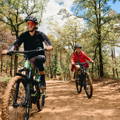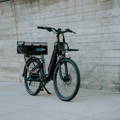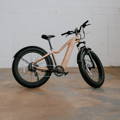Average Cycling Speed: How to Go Faster
Written by: Rémy Rossi | April 5, 2025 | Time to read 5 min
What’s the average speed of an electric bike? I’ve crunched some numbers and done some digging to reveal helpful information on e-Bike speed.

More about the Author: Remy Rossi
Rémy Rossi is a bike writer, mechanic, and educator who got his start in community-based bike shops and co-ops. With a decade in the industry, he still wrenches on bikes when he can and plays bike polo on a fixie.

It’s simple to find out how fast electric bikes can go, but at what speed do riders actually ride their e-Bikes? Electric bikes in the US are limited to 20 mph or 28 mph, depending on their classification, but I’m more interested in the average speed of riders out in the real world. In this article, I’ll discuss the speed of e-Bikes and tips for bumping up the pace.
What is the average speed of cyclists?

- In the city: Your pace when cycling around town is often limited by traffic obstacles like intersections, stop signs, and a higher density of other bikes, cars, and pedestrians around. Well-designed bike lanes and timed corridors can increase the average speed, but the average speed clocks in at between 8 mph to 14 mph in the city.
- Beyond the city limits: When cycling outside urban areas, performance depends more on the type of ride and the cyclist’s fitness. Recreational cyclists typically ride at around 12-15 mph, while experienced cyclists reach 15-22 mph.
- Professional cyclists: Now these numbers go bonkers compared to the speeds of us mere mortals. Pro road racers can sustain 25-31 mph on flat terrain and approach speeds of up to 50 mph during sprints! And you don’t even want to know how fast they go when descending…
Average speed based on bike type

- Road bikes: Built to be as efficient as possible on smooth roads, road bikes balance lightweight specs, aerodynamics, and speed. Actual speed will depend, of course, on rider fitness and the route gradient— there are some seriously steep climbs and descents out there.
- Mountain bikes: MTBs have larger wheels and suspension-equipped frames to travel faster over rugged terrain, both up and down the mountain.
- Hybrid bikes: Ideal for city and recreational use, hybrid bikes average around the 9-15 mph mark. They are built for comfort and efficiency, getting you to your destination moderately quickly.
- Electric bikes: E-Bikes provide a boost so riders can travel faster and farther with the same effort. Class 1 and Class 2 e-Bikes are limited to 20 mph, while a Class 3 e-Bike can assist up to 28 mph.
E-Bike riders do ride faster, on average
It’s common sense— electric bike riders should travel faster, on average, but what does the science say? I’ve tracked down cold-hard facts on the speed of e-Bike riders compared to cyclists on traditional bicycles.
A German study on cycling concluded that e-Bike users are “significantly faster than riders of conventional bicycles”. Pedelec riders (Class 1 or 2) were, on average, 2 km/h faster than traditional cyclists, while the speed of S-pedelec riders (Class 3 e-Bike) was around 9 km/h higher.
That speed increase translates to a moderate 1-5 mph boost on average, hinting at the fact that users enjoy e-Bikes not because of their high top speeds but, rather, because of the assistance that lets them pedal at similar speeds with less effort.
Factors that affect cycling speed

Weather conditions
Rain, strong winds, and colder temperatures tend to slow cyclists down. Cold weather requires more energy from the rider, and hot weather can lead to quicker overheating and dehydration.
Weight
The weight of both the cyclist and the bike is crucial. Lighter bikes perform better and can extend battery range. Aerodynamics also plays a role; streamlined clothing and helmets reduce wind resistance. Properly inflated and smooth tires optimize speed.
Physical condition
Regular exercise is essential for improving average speed. Amateur cyclists should train 4-5 hours weekly, while professionals might exceed 20 hours and follow strict diets.
How to increase your average cycling speed

- Reduce weight: A lighter bike and rider mean that the motor doesn’t need to work as hard, helping reach your top speed quicker. Lightweight e-Bikes provide great efficiency, and shedding a few pounds can be a win-win for you and your bike!
- Improved fitness: Regular training and increased endurance will help you go faster. Better fitness won’t necessarily increase your top speed on an e-Bike, however, since the assistance maxes out at 20 or 28 mph.
- Better aerodynamics: Close-fitting cycling clothing and streamlined bikes cut down on wind resistance that can slow you down and decrease efficiency.
- Ride in a group: Group rides are an underrated way to increase your speed. You’ll naturally be pushed to keep up with the pace of the group, plus the drafting advantage helps you ride faster due to reduced air resistance.
- Maintain your bike: Yet another reminder to maintain your bike, take care to inflate the tires, make any repairs, and clean and lubricate the drivetrain for optimal performance.
How fast do electric bikes go?
Class 3 electric bikes are limited to a maximum of 28 mph in the US, while Class 1 and 2 models top out at 20 mph. But for a deeper look, check out the fastest electric bikes and learn more about how fast e-Bikes actually go when dashing around town and zooming up trails. Hop on your e-Bike and see how fast you clock on the speedometer! But remember to ride safely and within your local area's rules, of course.
Key Takeaways
- E-Bike Riders Are Faster: Studies show e-Bike riders travel 1-5 mph faster on average, with Class 3 e-Bikes providing the biggest boost. The real benefit? Maintaining speed with less effort.
- What Affects Your Speed: Factors like weather, bike weight, aerodynamics, and rider fitness impact performance. Lighter bikes, streamlined gear, and proper maintenance help maximize speed.
- How to Ride Faster: Improve speed by reducing weight, training, optimizing aerodynamics, riding in groups, and maintaining your bike—even with e-Bike limits, these tweaks make a difference.


